Church Walkway Replacement Sparks Debate Over Historic Aesthetics
November 15, 2024 | Baltimore County, Maryland
This article was created by AI summarizing key points discussed. AI makes mistakes, so for full details and context, please refer to the video of the full meeting. Please report any errors so we can fix them. Report an error »

During a recent government meeting, discussions centered on a proposal from Glendon United Methodist Church to replace its existing flagstone walkways with broom-finished concrete. The church, built in 1931 in the Gothic Bridal style, has faced ongoing maintenance issues with the flagstone, which has deteriorated over time, leading to safety concerns for congregants.
The church's application highlights that the flagstone walkways, which cover 1,742 square feet, have been a source of tripping hazards and require annual maintenance due to freeze-thaw cycles. Although the church is considered a non-contributing resource within the Glendon District, it still possesses architectural merit, prompting a review of the proposed changes under the county's historic design guidelines.
Commission members raised several questions regarding the original materials of the walkways, the reasons for their deterioration, and the potential for using stamped concrete to maintain a similar aesthetic. Some commissioners expressed concerns about the visual impact of bright white concrete against the church's stone facade, suggesting alternatives such as incorporating stone edges or using textured concrete to blend better with the existing architecture.
The staff recommended that the Local Preservation Commission (LPC) evaluate whether the proposed replacement aligns with design guidelines and the overall character of the historic district. The LPC is tasked with determining the appropriateness of the changes and may approve, modify, or deny the application based on their findings. The meeting concluded with a consensus that while the replacement of the walkways is necessary, modifications to the proposal could enhance both safety and aesthetic appeal.
The church's application highlights that the flagstone walkways, which cover 1,742 square feet, have been a source of tripping hazards and require annual maintenance due to freeze-thaw cycles. Although the church is considered a non-contributing resource within the Glendon District, it still possesses architectural merit, prompting a review of the proposed changes under the county's historic design guidelines.
Commission members raised several questions regarding the original materials of the walkways, the reasons for their deterioration, and the potential for using stamped concrete to maintain a similar aesthetic. Some commissioners expressed concerns about the visual impact of bright white concrete against the church's stone facade, suggesting alternatives such as incorporating stone edges or using textured concrete to blend better with the existing architecture.
The staff recommended that the Local Preservation Commission (LPC) evaluate whether the proposed replacement aligns with design guidelines and the overall character of the historic district. The LPC is tasked with determining the appropriateness of the changes and may approve, modify, or deny the application based on their findings. The meeting concluded with a consensus that while the replacement of the walkways is necessary, modifications to the proposal could enhance both safety and aesthetic appeal.
View full meeting
This article is based on a recent meeting—watch the full video and explore the complete transcript for deeper insights into the discussion.
View full meeting
